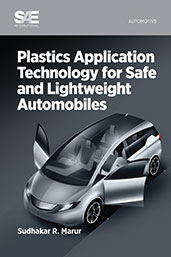Book

Plastics Application Technology for Lightweight Automobiles
2013-08-06
This book is focused on the use of plastics in automobiles for traditional applications, as well as for more advanced uses such as under-the-hood components. Engineering thermoplastics offer the ability to tailor-make components from polymers, and to design parts for enhanced performance, new functionality, part integration, and elimination of secondary operations. Parts made from engineering thermoplastics can be manufactured within specified cost constraints, and using manufacturing methods that offer a wide range of production flexibility. A decade of research and real-world applications is presented by the authors on application technology development for various aspects of automotive design – concept design, CAD modeling, predictive engineering methods through CAE, manufacturing method simulation, and prototype and tool making.



